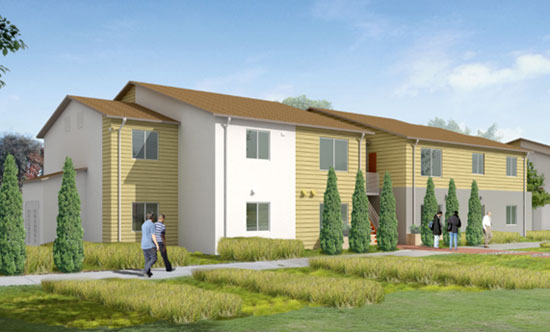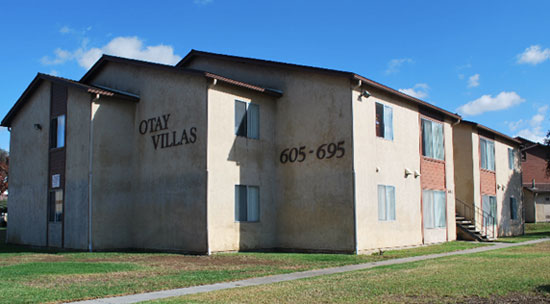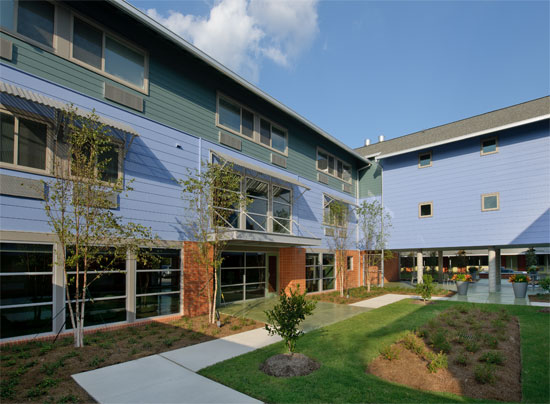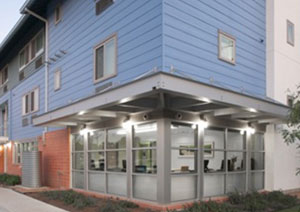Sustainable Extruded Aluminum Trim Profiles Deliver Aesthetics and Durability
![]() Continuing Education
Continuing Education
Use the following learning objectives to focus your study while reading this month’s Continuing Education article.
Learning Objectives - After reading this article, you will be able to:
- Identify the sustainability features of extruded aluminum architectural trim.
- Summarize the aesthetic and environmental benefits of specifying extruded aluminum architectural trim.
- Explore the profile and finish trim options that are available for use with fiber cement siding.
- Discuss moisture management and the use of aluminum flashing when designing durable sustainable moisture-free structures.
"God is in the details," one of several iconic phrases attributed to Mies van der Rohe, continues to haunt architects. Whether the meaning is a disguised plea for creating ornamentation for buildings or adding a few more inches to a roof overhang, details are where architects can and do make a difference. With today's focus on green materials, detailing needs to meet both an architectural design aesthetic and sustainability requirements. Specifying trim for use with fiber cement siding, is one instance where a knowledge of detailing can contribute to both.
Design Aesthetic
Manufactured to work as an integrated/complementary system with the major U.S. manufacturer of cementitious or fiber cement siding, extruded aluminum profiles are available in variety of choices. Their design, mostly driven by architects seeking cleaner details, adds a distinctive profile to interiors and exteriors of buildings. In addition, it breaks up the monotony of flat panel walls where the same siding products are used repeatedly. Installing aluminum trim rather than using wood trim or cutting and ripping fiber cement boards or panels is more convenient and saves time. "Using trim over panel joints becomes an architectural element and is a way of expressing the joints and defining their deliberate placement. It adds a level of architectural refinement," says Russell A. Hruska, AIA, principal and co-founder of Intexure Architects in Houston, Texas. In our climate, stucco often requires additional oversight to be correctly executed. Aluminum trim when used with fiber cement panels or lapped siding is more cost effective than stucco and provides long term durability while achieving our design aesthetic."
 |
Constructed from 75 percent to 100 percent post industrial and post consumer scrap, extruded aluminum trim meets requirements for sustainability and can contribute to LEED® points. It may also be specified for interior or exterior use. Applications include an increasingly wide range of building types wherever fiber cement panels or lap siding is specified. In recent years extruded aluminum trim has begun to replace traditional wood 1x2 and 1x4 trim on single-family homes and is increasingly preferred for multi-family structures.
Extruded aluminum trim products are intended for design aesthetics. They do not include an exterior insulation and finishing system (EIFS) —a type of building exterior wall cladding system that provides exterior walls with an insulated finished surface. Manufacturers usually state if their product does or does not include an insulation system. Since some extruded aluminum trim products on the market incorporate an EIFS, design professionals should note the exact description of each manufacturer's product and its performance expectations. As a general rule extruded aluminum trim products that are not part of an EIFS system are not designed or intended to be used in conjunction with an EIFS or similar system.
Nor do architectural trim profiles form a complete moisture management system. Always a critical feature of construction, a moisture management system is the province of the architect and builder who are responsible for designing and installing a code compliant building envelope. Again, manufacturers usually point out that extruded aluminum trim alone does not include a complete moisture management system, despite the fact that trim is designed with drain dams for vertical runs and shingle fashion for horizontal profiles. Some manufacturers do, however, supply moisture management products that complement their trim line and additionally help meet code requirements (see below).
Design professionals are also advised to consult with the siding manufacturer for "best practice" applications of extruded aluminum trim product in order to ensure color, dimensional and thickness match.
Prefabricated Trim Materials
Extruded aluminum adds durability and longevity to construction that other trim materials such as galvanized steel and polyvinyl chloride (PVC) lack (see sidebar Benefits of Extruded Aluminum).
Galvanized steel
While initially less expensive than extruded aluminum galvanized steel is less durable. The use of bare mill galvanized steel and aluminum flashing in direct contact with most claddings will increase chances of a chemical reaction, causing wear and break down on both products.
Polyvinyl chloride (PVC)
The third-most widely-produced plastic, and the least expensive also has limitations compared with extruded aluminum. One manufacturer of extruded aluminum trim profiles developed and manufactured PVC trim profiles to use with fiber cement siding and soffits, and still does. But through learned experiences and public demand, it began converting its profiles into more durable extruded aluminum. One hundred percent vinyl trim is susceptible to swelling and buckling when exposed to direct sunlight. Moreover, PVC trim with painted dark colors, which is increasingly the choice of architects and developers, may cause the product to warp. This comes about because excess solar heat, especially in hot climates, may be absorbed subjecting the PVC to distortion due to extremes of thermal expansion and contraction. Paint adhesion loss, blistering and peeling may also result.
Characteristics of extruded aluminum trim include:
- Adds a design aesthetic to a wide range of building types.
- Offers multiple profile choices.
- Typically fabricated from custom die-extruded heavy duty 6063 T-5 aluminum alloy with a coating that protects against harsh weather conditions and allows for paint adhesion.
- Typically designed to match color, metal thickness and dimensions of the country's major cementitious siding manufacturer.
- Available in anodized, standard color palette, or ready to paint finishes
- Sustainable material, 75 percent to 100 percent post industrial and post consumer scrap. Can contribute to LEED® points.
- Replaces time-consuming cutting and ripping of fiber cement panels or boards for trim use
- Can be used for interior and exterior weather conditions.
- Highly durable and will long outlast caulk
- Poses no health or physical hazard. {Aluminum trim products are defined as "articles," by the Occupational Safety and Health Administration's (OSHA) and are therefore exempt from the requirement of publishing material safety data sheets.}
| CHARACTERISTICS OF EXTRUDED ALUMINUM |
The most abundant mineral in the earth's crust, aluminum is derived from bauxite, which is mined from the earth. After processing, the resultant alumina undergoes a smelting and alloying process that produces solid logs of cast metal from which extruded aluminum shapes or profiles are made. Most extruded shapes for architectural use are fabricated from AA 6063 an aluminum alloy, with magnesium and silicon as the alloying elements. Type 6063-T5 Aluminum, commonly referred to as the architectural alloy, has a very smooth surface and is the best alloy suited for anodizing applications. The T5 designation indicates it has been artificially aged and moderately heat-treated. Aluminum extrusion is a highly versatile metal-forming process that has a wide array of physical characteristics. These include:
|
| USING ALUMINUM TRIM FOR AFFORDABLE HOUSING RENOVATION | ||||
The San Diego Housing Commission wanted to renovate Picador Boulevard Apartments, an affordable housing complex in San Diego, CA consisting of 78 units in 11 buildings that was originally built in 1978. Sillman Wright Architects selected a combination of fiber cement panels and stucco to create a much needed face lift for the outdated apartments. "We really wanted to transform these buildings and create a sense of home for the residents," says Brett Tullis AIA, LEED AP BD + C. "We wanted a cleaner look for the buildings that would be durable and low maintenance to contrast the existing chunky wood trim and yellow stucco that was so typical of that era. We selected the fiber cement panels with the aluminum trim because it will resist abuse and perform and is a great looking, cost effective alternative to the traditional fiber cement panel detailing. It gave us the sharper more modern detailing we wanted without additional material or labor costs."
|
| MANY USES OF ALUMINUM TRIM FOR NEW HOPE HOUSING, INC. | ||||
The new 2424 Sakowitz affordable housing facility in Houston, Texas, developed by New Hope Housing, Inc, and designed by Val Glitsch, FAIA, LEED® AP, Houston, is three-story wood construction on a concrete foundation. The exterior is a mix of brick, fiber cement panels and lap siding. Pre-manufactured aluminum trim was placed above, below and between the different types of fiber cement siding; above windows and doors and below the siding over brick. It also was used for both inside and outside corners and where panels meet the siding boards. "The alternative to pre-manufactured trim? Wood trim gives a very different aesthetic. It is bulkier and, for water infiltration concerns, can only be used for vertical joints," says Glitsch. "We could have had a metal shop make up the trim pieces, but that's not always a good way to get a quality, consistent, cost-effective product. And the heavier-weight 'extreme trim' we used makes it easier to install the product properly." |
Trim Profiles
Typically fabricated from custom die-extruded from heavy duty 6063 T-5 aluminum alloy, trim profiles have a coating that protects against harsh weather conditions. Since siding panels will expand and contract due to changes in temperature a 1/8-in gap should be allowed between panels and trim.
Manufacturers typically warrant defective-free products for a period of 10 years for the original purchaser unless otherwise stated for the specific product ordered. They are further warranted as to adequacy of design, provided products are properly specified and installed.
Examples of trim profiles include:
Vertical and horizontal stucco bead trim
Vertical and horizontal stucco bead trim each serve as an expansion joint between panels. Horizontal trim is designed to work as a system with vertical bead trim. Both work with all panel profiles and finishes.
 |
Drawings provided by Tamlyn Vertical stucco bead trim with typical dimensions serves as expansion joint between panels. |
 |
Drawings provided by Tamlyn Horizontal stucco bead is designed to work with vertical stucco bead trim for use with fiber cement or wood panels and not for use with EIFS systems or similar products. |
These aluminum trim profiles are not part of an Exterior Insulation Finishing System (EIFS) and not designed or intended to be used in an EIFS or similar system. Designed for fiber cement or wood panels only.
Vertical batten reveal
This profile duplicates the look of a wood batten without any maintenance rotting/splitting problems. In addition it serves as a rustproof flashing between the siding and the building sheathing. Typical standard length is 10 ft. |
|
Drawings provided by Tamlyn Horizontal stucco bead is designed to work with vertical stucco bead trim for use with fiber cement or wood panels and not for use with EIFS systems or similar products. |
Batten corner
A batten corner trim profile can add a distinctive corner form for structures with vertical siding panels.
 |
|
Drawings provided by Tamlyn Batten corner profile is typically available in lengths of 10 ft. |
Panel inside corner
One manufacturer has patented a design that duplicates the look of a wood corner piece. It can be used with panel siding.
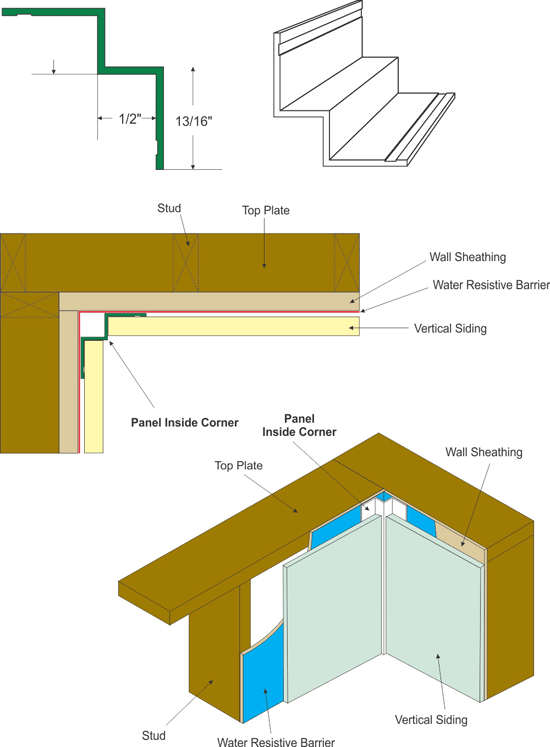 |
|
Drawings provided by Tamlyn Inside corner extruded aluminum batten eliminates the need for a wood corner piece. |
Panel Vertical Reveal
Designed for wood and steel stud construction the aluminum trim provides a reveal for both plank lap and panel siding. The reveal also serves as rustproof flashing between planks and panels. Plank and panel reveals should not be used for horizontal joints.
 |
|
Drawings provided by Tamlyn Typical dimensions for plank vertical reveal. Dimensions for panel vertical reveal are slightly smaller. |
Panel Open Outside Corner
Extruded aluminum open corner profile offers an alternative to the more familiar closed corner trim. It can be used with both plank and panel siding.
 |
|
Drawings provided by Tamlyn Panel open outside corner. Dimensions of trim used with panel siding are slightly smaller than those used with plank siding. |
Panel Bullnose Outside Corner
This profile solves trim issues when vertical siding has multiple pitches, as, for example, with the installation of a bay window. It can be used with both panel and plank siding.
 |
|
Panel bullnose outside corner profile is useful for trimming siding with different pitches. Drawings provided by Tamlyn |
Keeping Moisture Out
Walls with cladding leak just like masonry walls and must drain and dry moisture since water is the most significant factor in the premature deterioration of buildings. Leakage paths exist at any opening in the wall surface, whether intended or unintended. Joints between materials and around windows and doors, vents, cracks, and porous surfaces are all potential entry points for water. As mentioned above, trim manufacturers either recommend or offer moisture management products that help meet code requirements.
Code Requirements
According to the International Code Council (ICC) 2012 Section 1405.4 Flashing, "1405.4 Flashing. Flashing shall be installed in such a manner so as to prevent moisture from entering the wall or to redirect it to the exterior. Flashing shall be installed at the perimeters of exterior door and window assemblies, penetrations and terminations of exterior wall assemblies, exterior wall intersections with roofs, chimneys, porches, decks, balconies and similar projections and at built-in gutters and similar locations where moisture could enter the wall. Flashing with projecting flanges shall be installed on both sides and the ends of copings, under sills and continuously above projecting trim."
The International Residential Code (IRC) 2012 states: Wall Covering – Section R703 Exterior Covering: R703.1 General. Exterior walls shall provide the building with a weather-resistant exterior wall envelope. The exterior wall envelope shall include flashing as described in Section R703.8. The exterior wall envelope shall be designed and constructed in a manner that prevents the accumulation of water within the wall assembly by providing a water-resistant barrier behind the exterior veneer as required by Section R703.2 and a means of draining to the exterior water that enters the assembly. R703.8 Flashing. Approved corrosion-resistant flashing shall be applied shingle-fashion in a manner to prevent entry of water into the wall cavity or penetration of water to the building structural framing components. Self-adhered membranes used as flashing shall comply with AAMA (American Architectural Manufacturers Association) 711. The flashing shall extend to the surface of the exterior wall finish.
Flashing
Aluminum has long been the flashing of choice because it is widely available, inexpensive, lightweight and fairly easy to handle. A coil of aluminum trim coated on both sides with a paint system that is specifically formulated for residential applications will serve most residential and light commercial applications.
Pre-cut and pre-formed profiles designed for siding, counter, brick ledge, window and other areas, have the advantage of being available in custom sizes and colors that match trim and siding.
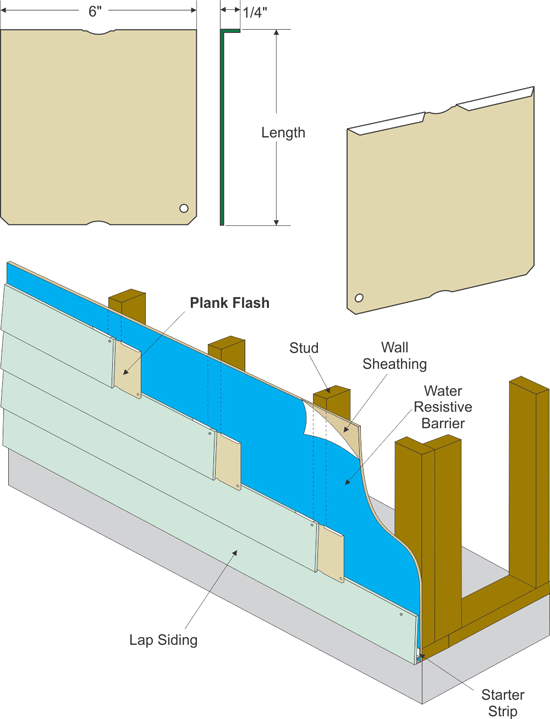 |
|
Drawings provided by Tamlyn Aluminum butt joint flashing is pre-cut and easily installed. |
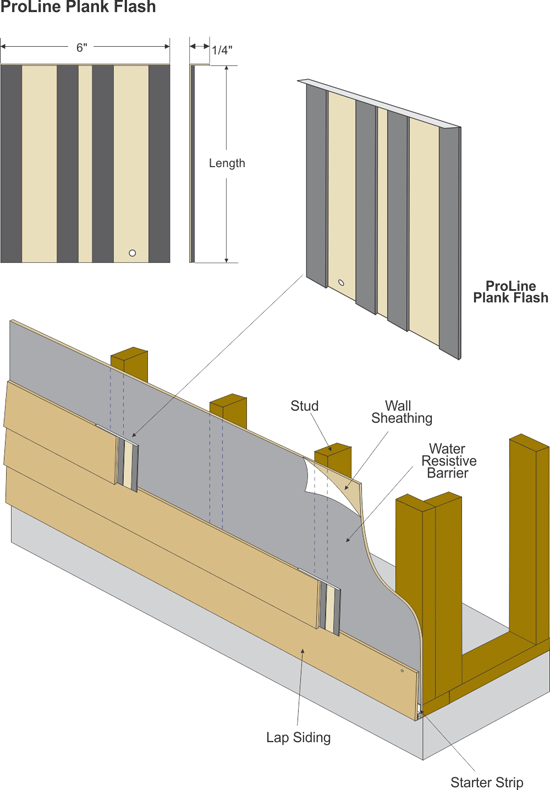 |
|
Drawings provided by Tamlyn Example of aluminum butt joint flashing with strips of EPDM rubber, which diverts water downward. |
One example of an aluminum profile newly on the market is butt joint flashing with strips of non-polluting EPDM (ethylene propylene diene monomer (M-class) rubber.) It reduces moisture penetration behind the joint where two planks butt together and drains water over the top edge of the last full course of siding. The puncture resistant flashing is primed or painted on both sides in order to eliminate any reaction with the fiber cement of the siding. The coating or paint also prevents reflective mirror-like flashback as is found when traditional unfinished metal flashing is used. The stiff aluminum material helps hold a tighter seal against the siding and diverts water downward so as not to allow water pressure to enter and wick off to the sides and find its way behind the siding. No nailing is required as the flashing slips beneath the lap siding, so no additional holes are introduced in the wall. Aluminum flashing is preferred to using cut pieces of traditional housewrap to prevent water penetration at lap siding butt joints. The reason is that housewrap is intended to perform as an air barrier, not as flashing. Housewrap also has limited ultra violet exposure life when uncovered during construction or when visible at butt joints Roofing felt is another material that is less durable than aluminum flashing because it tends to weep (allows water to penetrate) and break down over time.
Manufacturers advise always applying a layer of self-stick material such as asphalt or butyl tape before installing aluminum flashing on treated lumber. This prevents a chemical reaction between the flashing and copper azole in treated lumber. (Copper azole is a wood preservative replacement for chromated copper arsenate (CCA) which has been phased out for most residential applications.)
Housewrap and Rainscreens
Exterior walls performance requirements are included in 2009 ICC 1403.2 "Weather protection: Exterior walls shall provide the building with a weather-resistant exterior wall envelope. The exterior wall envelope shall include flashing, as described in Section 1405.4 (above.) The exterior wall envelope shall be designed and constructed in such a manner as to prevent the accumulation of water within the wall assembly by providing a water-resistive barrier behind the exterior veneer, as described in Section 1404.2, and a means for draining water that enters the assembly to the exterior. Protection against condensation in the exterior wall assembly shall be provided in accordance with Section 1405.3. (1405.3 Vapor retarders. Class I or II vapor retarders shall be provided on the interior side of frame walls in Zones 5, 6, 7, 8 and Marine 4.)"Housewrap
The primary insurance of moisture mitigation for the building envelope is housewrap that is specifically designed to allow water or moisture to drain. There are several advantages to using an integrated wrap/drainage product. These include requiring no additional installation step and no design change to the wall/siding assembly. One type of housewrap on the market eliminates excess moisture from an exterior wall by providing drainage space between the housewrap and exterior sheathing. This is achieved by bonding very small spacers to the wrap.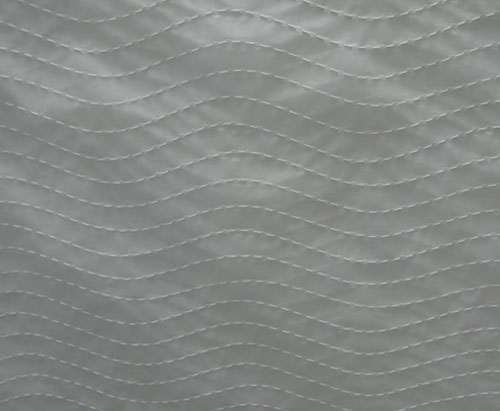 |
|
Photo provided by Tamlyn Example of a moisture management housewrap with 1.5 mm spacers that provide a drainage space between the sheathing and cladding material. |
Rainscreen
Another option for meeting code requirements is a rainscreen system. A rainscreen is a moisture management technique for controlling rain entry in an exterior wall. It generally comprises an air space immediately behind exterior cladding plus a water resistive barrier that wraps the building wall assembly. The air space that is created by the rainscreen between the back of the cladding and the face of the water resistive barrier is designed to reduce the forces that draw water into the assembly. Water that does reach the back of the cladding drain from the wall assembly via the space created by the rainscreen. In addition to the drainage capabilities, a rainscreen system also helps accelerate the drying of water vapor that accumulates in the interior wall assembly by moving air throughout the air space. There are several rainscreen options available:
- Installing "weeps" in masonry construction. "Weeps" or "weeper holes" are small openings left in the outer wall as an outlet for water inside a building to move outside the wall and evaporate.)
- Constructing a rainscreen wall using furring strips that space the cladding away from the wall. This provides a vent space that helps to dry the back of the siding. Traditionally, layered tarpaper and flashing behind the furring strips created what is called a drainage plane. Now housewrap is more commonly used than tarpaper.
- Rainscreen products. These can be batten strips in the form of plastic slats typically 1-1/2-in x ½-in placed on top of the housewrap.
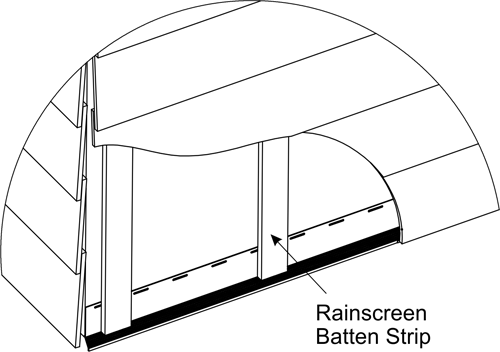 |
|
Photo provided by Tamlyn Example of a rainscreen strips product used to create a cavity between the cladding and building wall assembly. |
Trim finishes
Extruded aluminum trim is typically available in standard color finishes or primed ready-to paint, and also in anodized finishes.
Pre-colored
Manufacturers recommend one of the standard palette colors because each is made to the exact standards of the largest U.S. cementitious siding manufacturer. The fully engineered paint-coating system is computer matched, fade resistant, uses non-VOC (volatile organic compound), and is expected to last eight years.
Custom color
Design professionals requiring custom colors, can specify a primed ready-to-paint finish. Manufacturers typically provide a painting guide and recommend following a paint manufacturer's instructions for an eco-friendly, sustainable, recyclable, fire resistant direct to metal (DTM) paint material. Aluminum does not rust. It can, however, corrode if its protective coating is uncovered. Manufacturers recommend recoating trim after making end cuts or if there are surface scratches.
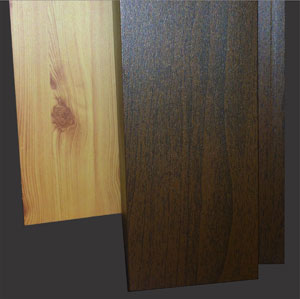 |
|
Photo provided by Tamlyn Examples of custom-patterned extruded aluminum trim. |
Custom pattern
Design professionals can also order trim in a custom pattern. In one example in an airport interior, the wallpaper pattern was repeated on the aluminum trim covering panel joints in order to provide a continuous unbroken appearance.
Clear anodized finish
A clear anodized finish is an electrochemical conversion process that deposits an oxide film on the aluminum trim. While a natural oxidation process occurs on bare aluminum, producing the controlled oxidation process artificially creates a thicker, harder, and more durable "oxide film." Clear anodized is an extremely durable finish and is resistant to most forms of corrosion. Design professionals should note that clear anodized finishes can vary slightly from one piece of trim to another and should consider this characteristic before ordering.
Special color anodized finishes
Manufacturers also offer special color anodized finishes if required. Typical colors are gold, black and bronze. Again, design professionals should note that finishes can vary from one piece of trim to another. Typically, the color of the anodizing will fall within a certain range, which usually can be determined prior to anodizing. The manufacturer should provide anodized color detailes upon request. Specifyers should required anodized coating thickness be tested in accordance with ASTM B244-68.
LEED® Credits
Extruded aluminum trim products are typically made from 75-100% post industrial and post consumer scrap. They can contribute to credits in categories MR Credit 4 Recycled Content and MR Credit 5: Regional Materials of the U.S. Green Building Council's Leadership in Energy and Environmental Design (LEED®) certification, 2009 for New Construction and Major Renovations.
MR Credit 4: Recycled Content
1–2 Points
Intent
To increase demand for building products that incorporate recycled content materials, thereby reducing impacts resulting from extraction and processing of virgin materials.
Requirements
Use materials with recycled content such that the sum of postconsumer2 recycled content plus 1/2 of the preconsumer content constitutes at least 10 percent or 20 percent, based on cost, of the total value of the materials in the project. The minimum percentage materials recycled for each point threshold is 10 percent recycled content for one point; 20 percent recycled content for two points.
MR Credit 5: Regional Materials
1–2 Points
Intent
To increase demand for building materials and products that are extracted and manufactured within the region, thereby supporting the use of indigenous resources and reducing the environmental impacts resulting from transportation.
Requirements
Use building materials or products that have been extracted, harvested or recovered, as well as manufactured, within 500 miles of the project site for a minimum of 10 percent or 20 percent, based on cost, of the total materials value.
Conclusion
Available in a number of configurations, extruded aluminum trim can add architectural distinction to both the interiors and exteriors of a wide range of building types. Typically manufactured to work as a system with cementitious or fiber cement panel or lap siding, it is more convenient and easier to install than trim made from wood or fiber cement panels and saves labor time. Since aluminum is 75 percent to 100 percent post industrial and post consumer scrap, it also sustainable and can contribute to LEED points. While it is critical that design professionals understand how to incorporate water and moisture management systems in building design, they should be aware that trim products by themselves do not necessarily include moisture management or insulation systems.

